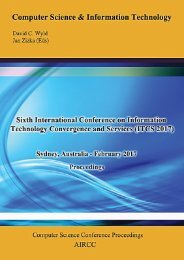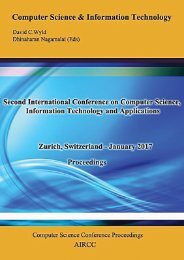CoSIT 2017
Fourth International Conference on Computer Science and Information Technology ( CoSIT 2017 ), Geneva, Switzerland - March 2017
Fourth International Conference on Computer Science and Information Technology ( CoSIT 2017 ), Geneva, Switzerland - March 2017
You also want an ePaper? Increase the reach of your titles
YUMPU automatically turns print PDFs into web optimized ePapers that Google loves.
Computer Science & Information Technology (CS & IT) 45<br />
K<br />
1−<br />
p<br />
where K<br />
p<br />
= (1− p)<br />
and k p<br />
= ln<br />
(17)<br />
p<br />
are constants determined by the label-error probability p .<br />
5. EXPERIMENT<br />
We have evaluated our approach on sets of Arabic characters. Figure 1 shows some of the data<br />
used for the purpose of learning and recognition. In total we use, 18 distinct classes of Arabic<br />
characters and for each class there are 200 samples. The landmarks are placed uniformly along<br />
the length of the characters. The top row shows the example pattern used for training a<br />
representative set of shape-classes. The second row of the figure shows the configuration of mean<br />
strokes for each class. Finally, the third row shows the stroke centre-points.<br />
Figure 1: Raw 1 shows sample training sets. Raw 2 shows stroke mean shapes, Raw 3 shows stroke<br />
arrangements<br />
Table 1 shows the results for a series of recognition experiments. The top raw of the table shows<br />
the character shape class. For each shape-class, we have used 200 test patterns to evaluate the<br />
recognition performance. These patterns are separate from the data used in training. The raws of<br />
the table compare the recognition results obtained using a global point-distribution model to<br />
represent the character shape and using the stroke decomposition model described in this paper.<br />
We list the number of correctly identified patterns. In the case of the global PDM, the average<br />
recognition accuracy is 93.2% over the different character classes. However, in the case of the<br />
stroke decomposition method the accuracy is 97%. Hence, the new method offers a performance<br />
gain of some 5%.<br />
Table 1. Recognition Rate for shape-classes ( Full Character, Stroke-based arrangements )





